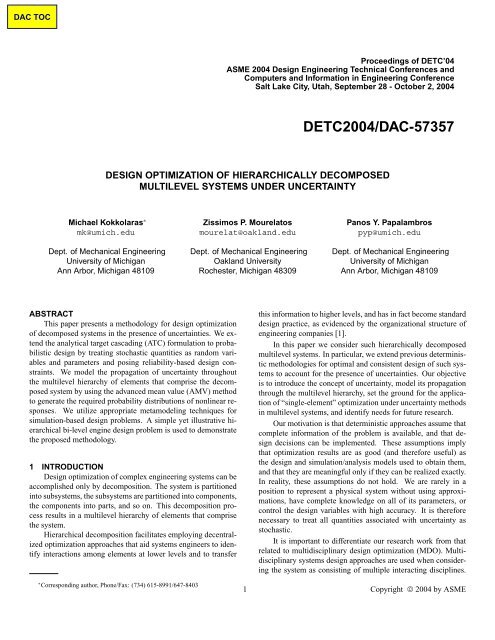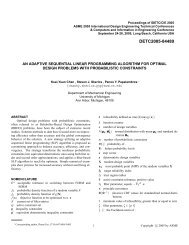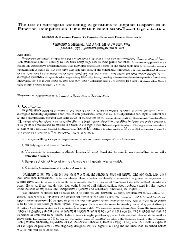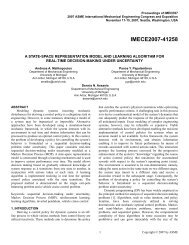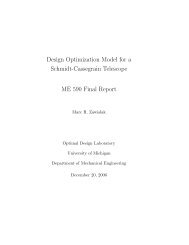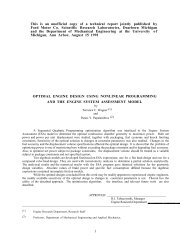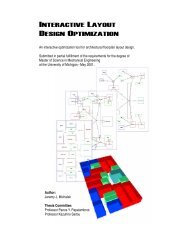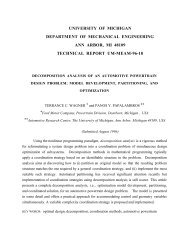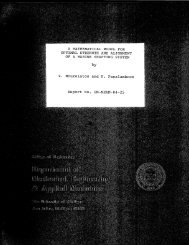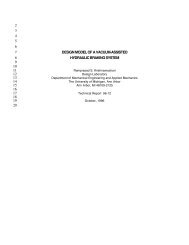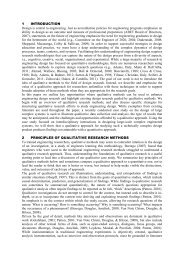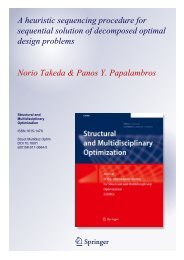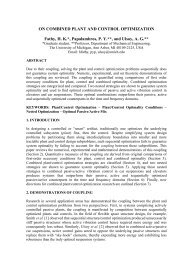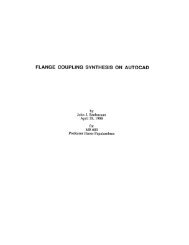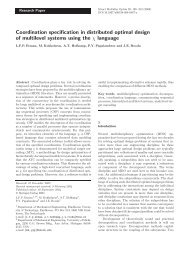Design Optimization of Hierarchically Decomposed Multilevel ...
Design Optimization of Hierarchically Decomposed Multilevel ...
Design Optimization of Hierarchically Decomposed Multilevel ...
Create successful ePaper yourself
Turn your PDF publications into a flip-book with our unique Google optimized e-Paper software.
Proceedings <strong>of</strong> DETC’04<br />
ASME 2004 <strong>Design</strong> Engineering Technical Conferences and<br />
Computers and Information in Engineering Conference<br />
Salt Lake City, Utah, September 28 - October 2, 2004<br />
DETC2004/DAC-57357<br />
DESIGN OPTIMIZATION OF HIERARCHICALLY DECOMPOSED<br />
MULTILEVEL SYSTEMS UNDER UNCERTAINTY<br />
Michael Kokkolaras ∗<br />
mk@umich.edu<br />
Dept. <strong>of</strong> Mechanical Engineering<br />
University <strong>of</strong> Michigan<br />
Ann Arbor, Michigan 48109<br />
Zissimos P. Mourelatos<br />
mourelat@oakland.edu<br />
Dept. <strong>of</strong> Mechanical Engineering<br />
Oakland University<br />
Rochester, Michigan 48309<br />
Panos Y. Papalambros<br />
pyp@umich.edu<br />
Dept. <strong>of</strong> Mechanical Engineering<br />
University <strong>of</strong> Michigan<br />
Ann Arbor, Michigan 48109<br />
ABSTRACT<br />
This paper presents a methodology for design optimization<br />
<strong>of</strong> decomposed systems in the presence <strong>of</strong> uncertainties. We extend<br />
the analytical target cascading (ATC) formulation to probabilistic<br />
design by treating stochastic quantities as random variables<br />
and parameters and posing reliability-based design constraints.<br />
We model the propagation <strong>of</strong> uncertainty throughout<br />
the multilevel hierarchy <strong>of</strong> elements that comprise the decomposed<br />
system by using the advanced mean value (AMV) method<br />
to generate the required probability distributions <strong>of</strong> nonlinear responses.<br />
We utilize appropriate metamodeling techniques for<br />
simulation-based design problems. A simple yet illustrative hierarchical<br />
bi-level engine design problem is used to demonstrate<br />
the proposed methodology.<br />
1 INTRODUCTION<br />
<strong>Design</strong> optimization <strong>of</strong> complex engineering systems can be<br />
accomplished only by decomposition. The system is partitioned<br />
into subsystems, the subsystems are partitioned into components,<br />
the components into parts, and so on. This decomposition process<br />
results in a multilevel hierarchy <strong>of</strong> elements that comprise<br />
the system.<br />
Hierarchical decomposition facilitates employing decentralized<br />
optimization approaches that aid systems engineers to identify<br />
interactions among elements at lower levels and to transfer<br />
∗ Corresponding author, Phone/Fax: (734) 615-8991/647-8403<br />
this information to higher levels, and has in fact become standard<br />
design practice, as evidenced by the organizational structure <strong>of</strong><br />
engineering companies [1].<br />
In this paper we consider such hierarchically decomposed<br />
multilevel systems. In particular, we extend previous deterministic<br />
methodologies for optimal and consistent design <strong>of</strong> such systems<br />
to account for the presence <strong>of</strong> uncertainties. Our objective<br />
is to introduce the concept <strong>of</strong> uncertainty, model its propagation<br />
through the multilevel hierarchy, set the ground for the application<br />
<strong>of</strong> “single-element” optimization under uncertainty methods<br />
in multilevel systems, and identify needs for future research.<br />
Our motivation is that deterministic approaches assume that<br />
complete information <strong>of</strong> the problem is available, and that design<br />
decisions can be implemented. These assumptions imply<br />
that optimization results are as good (and therefore useful) as<br />
the design and simulation/analysis models used to obtain them,<br />
and that they are meaningful only if they can be realized exactly.<br />
In reality, these assumptions do not hold. We are rarely in a<br />
position to represent a physical system without using approximations,<br />
have complete knowledge on all <strong>of</strong> its parameters, or<br />
control the design variables with high accuracy. It is therefore<br />
necessary to treat all quantities associated with uncertainty as<br />
stochastic.<br />
It is important to differentiate our research work from that<br />
related to multidisciplinary design optimization (MDO). Multidisciplinary<br />
systems design approaches are used when considering<br />
the system as consisting <strong>of</strong> multiple interacting disciplines.<br />
1 Copyright © 2004 by ASME
Several approaches for MDO have been developed during the<br />
1990’s, all <strong>of</strong> which had as an objective the coordination <strong>of</strong> the<br />
interacting disciplines during the design optimization process,<br />
mostly using single- or bi-level formulations [2, 3]. These approaches<br />
are non-hierarchical in the sense that the disciplines are<br />
not decomposed into multilevel hierarchies. Discipline outputs<br />
are inputs to other disciplines and vice versa. This is the significant<br />
difference between MDO and our work. In hierarchically<br />
decomposed multilevel systems outputs <strong>of</strong> lower-level elements<br />
are inputs to higher-level elements, but not vice versa. An additional<br />
difference between design optimization <strong>of</strong> hierarchical<br />
multilevel systems and MDO is the type <strong>of</strong> decomposition, distinguished<br />
in [4] as object and aspect-based, respectively. Nevertheless,<br />
if it is possible to define a discipline-based hierarchy<br />
where lower-level discipline outputs are inputs to higher-level<br />
disciplines, our methodology would then provide an MDO approach<br />
to optimal design <strong>of</strong> hierarchical multilevel systems.<br />
To the best <strong>of</strong> our knowledge, no research work on addressing<br />
the presence <strong>of</strong> uncertainties in hierarchically decomposed<br />
multilevel systems has been reported in the literature. However,<br />
there is ongoing work to take uncertainties into consideration in<br />
the MDO framework [5–14].<br />
Most <strong>of</strong> these references utilize a simple first-order Taylor<br />
expansion [5, 7, 8] to calculate the mean and variance <strong>of</strong> the response<br />
in robust multidisciplinary design [14]. A “worst case”<br />
concept based on first-order sensitivity has been used to evaluate<br />
the performance range <strong>of</strong> a multidisciplinary system [9].<br />
Although the calculation <strong>of</strong> the response mean and variance<br />
using first-order sensitivity may be adequate for robustness calculations,<br />
it does not provide enough statistical information to<br />
consider design feasibility under uncertainty. As will be illustrated<br />
in this paper, probabilistic representation <strong>of</strong> the constraints<br />
requires complete probabilistic distributions <strong>of</strong> the system output.<br />
Reliability analysis using probabilistic distributions has<br />
been used in MDO [15–17]. Reliability analysis introduces an<br />
additional iteration loop resulting in coupled optimization problems<br />
that are computationally expensive. Response surfaces have<br />
been used to reduce the computational effort [5]. Decoupled<br />
reliability and optimization procedures in an MDO framework<br />
have been also proposed using approximate probabilistic constraint<br />
representations [16]. In general, a double-loop optimization<br />
process exists in reliability-based MDO analysis, which repeatedly<br />
calls expensive system-level multidisciplinary analyses.<br />
A single-loop collaborative reliability analysis method has been<br />
recently proposed in [15]. A Most Probable Point (MPP) reliability<br />
analysis method is combined with the collaborative disciplinary<br />
analyses to automatically satisfy the interdisciplinary<br />
consistency in reliability analyses. A single reliability optimization<br />
loop uses equality constraints to enforce disciplinary compatibility.<br />
Despite the use <strong>of</strong> a single optimization loop, it is<br />
a computationally expensive, ”all-at-once” procedure due to the<br />
presence <strong>of</strong> the equality discipline constraints.<br />
The paper is organized as follows. In the next section we<br />
present a methodology for optimal design <strong>of</strong> hierarchical multilevel<br />
systems, and extend its formulation to account for uncertainties.<br />
In Section 3 we address the issue <strong>of</strong> modeling uncertainty<br />
propagation in multilevel hierarchies and present some analytical<br />
examples. In Section 4 we present an efficient methodology<br />
to develop highly accurate metamodels. A simple yet illustrative<br />
simulation-based example is used in Section 5 to demonstrate<br />
our methodology for hierarchical multilevel system design.<br />
Finally, concluding remarks are summarized in Section 6.<br />
2 OPTIMAL DESIGN OF HIERARCHICALLY DECOM-<br />
POSED MULTILEVEL SYSTEMS<br />
Our framework for hierarchical multilevel system optimization<br />
under uncertainty is based on analytical target cascading<br />
(ATC). In this section we first review the deterministic formulation<br />
<strong>of</strong> ATC, and then we present its extension to account for<br />
uncertainties.<br />
2.1 Deterministic Formulation<br />
ATC is a mathematical methodology for translating (“cascading”)<br />
overall system design targets to element specifications<br />
based on a hierarchical multilevel decomposition [18–20]. The<br />
objective is to assess relations and identify possible trade-<strong>of</strong>fs<br />
among elements early in the design development process, and<br />
to determine specifications that yield consistent system design<br />
with minimized deviation from design targets. For an engineering<br />
corporation, ATC provides a means to dictate technical objectives<br />
to different design teams, knowing a-priori that these goals<br />
can be achieved without conflicting with those <strong>of</strong> other teams.<br />
Consistent system design can then be accomplished with minimum<br />
communication overhead, i.e., maximum efficiency, avoiding<br />
costly iterations late in the process.<br />
The ATC process is proven to be convergent when using a<br />
specific class <strong>of</strong> coordination strategies [21], and has been successfully<br />
applied to a variety <strong>of</strong> optimal design problems, e.g.,<br />
[22–25].<br />
We refer the reader to the above references for a detailed description<br />
<strong>of</strong> ATC. Here, we will briefly present the concept and<br />
the general mathematical formulation. In ATC a minimum deviation<br />
optimization problem is formulated and solved for each<br />
element in the multilevel hierarchy that reflects the decomposed<br />
optimal system design problem, cf. Figure 1. Therefore, responses<br />
<strong>of</strong> lower-level elements are inputs into higher-level elements.<br />
The ATC process aims at minimizing the gap between<br />
what higher-level elements “want” and what lower-level elements<br />
“can”. If design variables are shared among some elements<br />
at the same level, their consistency is coordinated by their<br />
parent element at the level above.<br />
The mathematical formulation <strong>of</strong> problem p i j , where i and j<br />
2 Copyright © 2004 by ASME
level i=0<br />
system j=1<br />
optimization inputs<br />
optimization outputs<br />
level i=1<br />
level i=2<br />
subsystem j=1 subsystem j=2<br />
subsystem j=n<br />
component j=1 component j=2 component j=m<br />
response and shared<br />
variable values cascaded<br />
down from the parent<br />
u<br />
r ij<br />
u<br />
y ij<br />
l<br />
r ij<br />
l<br />
y ij<br />
2.2 Non-deterministic Formulations<br />
In this section, the ATC formulation is modified to account<br />
for uncertainties. Stochastic quantities are represented by ranelement<br />
optimization problem p ij ,<br />
where r ij is provided by the<br />
analysis/simulation model<br />
r f ( r ,..., r , x , y )<br />
1<br />
ij ij ( i+ 1) k ( i+<br />
1) k ij ij<br />
=<br />
cij<br />
response and shared<br />
variable values passed<br />
up to the parent<br />
Figure 1.<br />
Example <strong>of</strong> hierarchically decomposed multilevel system<br />
response and shared<br />
variable values passed<br />
up from the children<br />
r<br />
y<br />
,..., r<br />
l<br />
l<br />
( i+ 1) k1 ( i+ 1) kcij<br />
,..., y<br />
l<br />
l<br />
( i+ 1) k1<br />
( i+ 1) kcij<br />
r<br />
,..., r<br />
u<br />
u<br />
( i+ 1) k1 ( i+ 1) kcij<br />
u<br />
u<br />
y( i+ 1) k<br />
,..., y<br />
1 ( i+ 1) kcij<br />
response and shared<br />
variable values cascaded<br />
down to the children<br />
denote level and element, respectively, is<br />
Figure 2.<br />
ATC information flow at element j <strong>of</strong> level i<br />
min<br />
˜x i j ,ε r i j ,εy i j<br />
subject to<br />
‖r i j − r u i j ‖2 2 + ‖y i j − y u i j ‖2 2 + εr i j + εy i j (1)<br />
∑ n i j<br />
k=1 ‖r (i+1)k − r l (i+1)k ‖2 2 ≤ εr i j<br />
∑ n i j<br />
k=1 ‖y (i+1)k − y l (i+1)k ‖2 2 ≤ εy i j<br />
g i j (r (i+1)1 ,...,r (i+1)ni j<br />
,x i j ,y i j ) ≤ 0<br />
h i j (r (i+1)1 ,...,r (i+1)ni j<br />
,x i j ,y i j ) = 0<br />
with r i j = f i j (r (i+1)1 ,...,r (i+1)ni j<br />
,x i j ,y i j ),<br />
where the vector <strong>of</strong> optimization variables ˜x i j consists <strong>of</strong> (n i j )<br />
children response design variables r (i+1)1 ,...,r (i+1)ni j<br />
, local design<br />
variables x i j , local shared design variables y i j (i.e., design<br />
variables that this element shares with other elements at<br />
the same level), and coordinating variables for the shared design<br />
variables <strong>of</strong> the children y (i+1)1 ,...,y (i+1)ni j<br />
, and where g i j<br />
and h i j denote local design inequality and equality constraints,<br />
respectively. Tolerance optimization variables ε r and ε y are introduced<br />
to coordinate responses and shared variables, respectively.<br />
Superscripts u (l) are used to denote response and shared<br />
variable values that have been obtained at the parent (children)<br />
problem(s), and have been cascaded down (passed up) as design<br />
targets (consistency parameters), cf. Figure 2. Note that<br />
although communication among levels, i.e., updating parameter<br />
values associated with the ATC process, is bi-directional, functional<br />
dependency is strictly hierarchical (as we emphasized in<br />
the introduction section). Higher-level responses are functions<br />
<strong>of</strong> lower-level responses, but not vice versa.<br />
Assuming that all the parameters have been updated using<br />
the solutions obtained at the parent- and children-problems,<br />
Problem (1) is solved to update the parameters <strong>of</strong> the parentand<br />
children-problems. This process is repeated until the tolerance<br />
optimization variables in all problems cannot be reduced<br />
any further.<br />
dom variables and parameters (denoted by upper case latin symbols).<br />
We present two alternative non-deterministic formulations<br />
for solving the hierarchical multilevel optimization problem in<br />
the presence <strong>of</strong> uncertainties. The stochastic formulation does<br />
not use a probabilistic representation <strong>of</strong> the design constraints,<br />
while the probabilistic one does. For the sake <strong>of</strong> simplicity, in<br />
the following formulations we will assume that all design variables<br />
are random and that there are no random parameters.<br />
2.2.1 Stochastic Formulation In the stochastic formulation,<br />
each random variable is represented by a parameter<br />
that describes its probabilistic characteristics. Typically, this parameter<br />
is the first moment, or mean, <strong>of</strong> the random variable. Responses<br />
and other functions <strong>of</strong> random variables are expressed as<br />
expected values. Thus, Problem (1) becomes<br />
min ‖E[R i j ] − µ u<br />
µ˜X ,ε R R i j<br />
‖ 2 2 + ‖µ Y i j<br />
− µ u Y i j<br />
‖ 2 2 + εR i j + εY i j (2)<br />
i j i j ,εY i j<br />
subject to<br />
∑ n i j<br />
k=1 ‖µ R (i+1)k<br />
− E[R i j ] l ‖ 2 2 ≤ εR i j<br />
∑ n i j<br />
k=1 ‖µ Y (i+1)k<br />
− µ l Y (i+1)k<br />
‖ 2 2 ≤ εY i j<br />
E[g i j (R (i+1)1 ,...,R (i+1)ni j<br />
,X i j ,Y i j )] ≤ 0<br />
E[h i j (R (i+1)1 ,...,R (i+1)ni j<br />
,X i j ,Y i j )] = 0<br />
with R i j = f i j (R (i+1)1 ,...,R (i+1)ni j<br />
,X i j ,Y i j ),<br />
where E[·] denotes the expectation operator.<br />
In words, this formulation attempts to<br />
1. Match the expected values <strong>of</strong> the local responses with the<br />
targets cascaded from the higher level; these targets are<br />
the optimal values <strong>of</strong> the random design variables, i.e., the<br />
means, <strong>of</strong> the higher-level problem.<br />
2. Match the optimal values <strong>of</strong> the random response design<br />
variables, i.e., the means, with the expected values <strong>of</strong> the<br />
children responses.<br />
3 Copyright © 2004 by ASME
3. Match the optimal values <strong>of</strong> the local and children random<br />
shared variables, i.e., the means, with the target values cascaded<br />
from the higher and lower levels, respectively.<br />
The challenge in solving stochastic optimization problems<br />
such as Problem (2) is that evaluating expectations requires<br />
knowledge <strong>of</strong> the probability density functions <strong>of</strong> the random<br />
variables and evaluation <strong>of</strong> multidimensional integrals.<br />
The solution <strong>of</strong> Problem (2) satisfies the design inequality<br />
and equality constraints in an average sense, but does not provide<br />
any information on the percentage <strong>of</strong> constraint violations due to<br />
uncertainty. In practical applications, however, there is a need to<br />
satisfy the constraints at a specified target reliability level.<br />
2.2.2 Probabilistic Formulation The constraints are<br />
thus reformulated. We now require that the probability <strong>of</strong> satisfying<br />
a constraint under the presence <strong>of</strong> uncertainties greater<br />
than some appropriately selected threshold, or, alternatively, that<br />
the probability <strong>of</strong> violating a constraint is less than some prespecified<br />
probability <strong>of</strong> failure. The formulation <strong>of</strong> Problem (2)<br />
becomes<br />
min<br />
µ˜X i j<br />
,ε R i j ,εY i j<br />
subject to<br />
‖E[R i j ] − µ u R i j<br />
‖ 2 2 + ‖µ Y i j<br />
− µ u Y i j<br />
‖ 2 2 + εR i j + εY i j (3)<br />
∑ n i j<br />
k=1 ‖µ R (i+1)k<br />
− E[R i j ] l ‖ 2 2 ≤ εR i j<br />
∑ n i j<br />
k=1 ‖µ Y (i+1)k<br />
− µ l Y (i+1)k<br />
‖ 2 2 ≤ εY i j<br />
P[˜g i j (R (i+1)1 ,...,R (i+1)ni j<br />
,X i j ,Y i j ) > 0] ≤ P f ,<br />
with R i j = f i j (R (i+1)1 ,...,R (i+1)ni j<br />
,X i j ,Y i j ),<br />
where P[·] denotes probability measure and P f is a vector <strong>of</strong> prespecified<br />
probability <strong>of</strong> failure thresholds.<br />
Note that the mathematical formulation <strong>of</strong> Problem (3) does<br />
not contain equality constraints. Equality constraints do not<br />
make sense in a probabilistic framework (it is meaningless to<br />
require that a function takes exactly a specific value under the<br />
presence <strong>of</strong> uncertainty, since the probability <strong>of</strong> a continuous<br />
random variable taking an exact value ois zero), one has to introduce<br />
some slack and treat equality constraints as inequality<br />
constraints. For example, if in a deterministic framework it is<br />
required that h(x) = 0, in a probabilistic framework it is required<br />
that | h(X) |≤ δ, where δ is a small positive constant, so that the<br />
constraint is formulated as P[| h(X) | −δ > 0] ≤ P f . Therefore,<br />
we rewrite equality constraints as inequality constraints and unite<br />
the two constraint function vectors into one, denoted by ˜g.<br />
Of course, there are applications where certain equality constraints<br />
are “more” important than others. For example, equality<br />
constraints representing governing equations <strong>of</strong> physical phenomena<br />
must be satisfied almost surely, i.e., with a probability<br />
close to one. For such “hard” constraints, the δ value and the<br />
acceptable probability <strong>of</strong> failure P f must be small, as opposed to<br />
“s<strong>of</strong>t” constraints, where these values can be relaxed at the designer’s<br />
discretion. A more elaborate discussion on this subject<br />
can be found in [26].<br />
Problem (3) can be solved with any <strong>of</strong> the available commercial<br />
s<strong>of</strong>tware packages or the methods reported recently in<br />
the literatures, e.g., the hybrid mean value (HMV) method or<br />
the sequential optimization and reliability assessment (SORA)<br />
method [27, 28]. We adopt a recently developed single-loop<br />
method that is as accurate as the HMV and the SORA methods,<br />
but much more efficient [29].<br />
3 PROPAGATION OF UNCERTAINTIES<br />
The responses <strong>of</strong> the elements in the multilevel hierarchy<br />
are typically nonlinear functions <strong>of</strong> the elements’ inputs, which<br />
include random variables and parameters. Thus, responses are<br />
themselves random variables, whose expected value must be<br />
computed to evaluate objective and constraints when solving<br />
probabilistic optimization problems. Moreover, estimated variance<br />
<strong>of</strong> responses is required if robustness considerations are included.<br />
Finally, in a multilevel hierarchy, responses <strong>of</strong> lower-level<br />
subsystems are inputs to higher-level subsystems. Therefore, it is<br />
necessary to obtain probability distribution information required<br />
for the solution <strong>of</strong> the higher-level problems. This is an issue <strong>of</strong><br />
outmost importance in design optimization <strong>of</strong> hierarchically decomposed<br />
multilevel systems. An efficient and accurate mechanism<br />
is required for propagating probabilistic information in the<br />
form <strong>of</strong> cumulative distribution and probability density functions<br />
throughout the hierarchy.<br />
3.1 Estimating Moments Using the Mean-Value First-<br />
Order Second-Moment Method<br />
In an initial effort, a mean-value first-order second-moment<br />
(MVFOSM) approach was adopted to estimate the mean and<br />
standard deviation <strong>of</strong> a nonlinear function <strong>of</strong> random variables<br />
[30]. Specifically, a first-order Taylor expansion about the current<br />
design, represented by the mean vector µ X <strong>of</strong> the random<br />
variables X, was used to linearize a nonlinear random response<br />
R:<br />
R = f (X) ≈ f (µ X ) +<br />
n<br />
∑<br />
i=1<br />
∂ f (µ X )<br />
∂X i<br />
(X i − µ Xi ), (4)<br />
where n is the dimension <strong>of</strong> the vector X. Assuming that all<br />
the random variables are statistically independent (uncorrelated),<br />
the first-order approximations <strong>of</strong> the mean and the variance <strong>of</strong> R<br />
were given by<br />
E[R] = µ R ≈ f (µ X ) (5)<br />
4 Copyright © 2004 by ASME
and<br />
Var[R] = σ 2 R ≈<br />
n<br />
∑<br />
i=1<br />
( ∂ f (µX )<br />
∂X i<br />
) 2<br />
σ 2 X i<br />
, (6)<br />
where f 0 is a particular value <strong>of</strong> the performance function. The<br />
reliability index β is then given by<br />
β = µ g<br />
σ g<br />
, (8)<br />
respectively.<br />
The advantage <strong>of</strong> this approach, besides efficiency, is that it<br />
allowed us to assume that the responses are normally distributed<br />
if all input random variables and parameters were normal. Therefore,<br />
propagation <strong>of</strong> uncertainty in ATC was modeled as a linear<br />
process. With the distribution information known, all that was<br />
necessary was the estimation <strong>of</strong> the first two moments, which<br />
characterize a normal distribution completely. The validity <strong>of</strong> the<br />
successive linearizations during the ATC process was ensured by<br />
virtue <strong>of</strong> the ATC consistency constraints that do not allow large<br />
deviations from current designs.<br />
To our knowledge, this linearization approach is currently<br />
embedded in all state-<strong>of</strong>-the-art s<strong>of</strong>tware packages for optimization<br />
under uncertainty. As will be demonstrated shortly, the linearization<br />
approach does a fairly good job in estimating the expected<br />
value <strong>of</strong> nonlinear functions <strong>of</strong> random variables. However,<br />
it can be quite inaccurate in estimating higher moments,<br />
e.g., the standard deviation. Moreover, it is limiting in that it<br />
does not provide us with the correct probability distribution information<br />
<strong>of</strong> the random nonlinear responses.<br />
It is also important to note that if the linearization approach<br />
is used to compute expectations in the stochastic formulation,<br />
Problems (1) and (2) generate identical solutions. There is no<br />
value in solving the stochastic ATC formulation if expectations<br />
are not computed exactly, which requires accurate probability<br />
distribution information and multidimensional integrations. This<br />
is an additional reason that may explain why the probabilistic<br />
constraint formulation is used universally today to solve nondeterministic<br />
problems.<br />
3.2 Generating Distributions Using the Advanced<br />
Mean Value Method<br />
In this paper, we utilize the advanced mean value (AMV)<br />
method to generate the cumulative distribution function (CDF)<br />
<strong>of</strong> a nonlinear response. The AMV method [31] is a computationally<br />
efficient method for generating the CDF <strong>of</strong> nonlinear<br />
functions <strong>of</strong> random variables. It improves the Mean Value (MV)<br />
prediction (Section 3.1) by using a simple correction to compensate<br />
for errors introduced from the Taylor series truncation. A<br />
response performance function R = f (X) is linearized as shown<br />
in Eq. (4) and its first and second order moments µ R and σ R are<br />
calculated using Eqs. (5) and (6), respectively.<br />
A limit state function is then defined as<br />
g(X) = f (X) − f 0 , (7)<br />
where µ g = µ R − f 0 and σ g = σ R . The CDF value <strong>of</strong> f at f 0 is<br />
calculated from the first-order relation<br />
P[ f ≤ f 0 ] = P[g ≤ 0] = Φ(−β), (9)<br />
where Φ is the standard normal cumulative distribution function.<br />
It is emphasized that Eq. (8) is equivalent to calculating the most<br />
probable point (MPP) using the linear approximation <strong>of</strong> Eq. (4).<br />
The MPP in the standard normal space is given by<br />
U ∗ = −β ∇g(X)<br />
|∇g(X)| . (10)<br />
In the original X space, the MPP coordinates vector is<br />
X ∗ = U ∗ σ x + µ x , (11)<br />
where µ x and σ x are the mean and standard deviation vectors,<br />
respectively, <strong>of</strong> the vector <strong>of</strong> random variables X.<br />
In the AMV method, the following relation is used instead<br />
<strong>of</strong> Eq. (9):<br />
P[ f ≤ f (X ∗ )] = Φ(−β), (12)<br />
i.e., the f 0 value at which the reliability index β is calculated is<br />
replaced by f (X ∗ ).<br />
To generate the CDF <strong>of</strong> R = f (X), the Most Probable Point<br />
Locus (MPPL) is first calculated using the simple MV method.<br />
The MPPL is defined by connecting all MPP’s for a discretized<br />
appropriate range <strong>of</strong> the performance function at points f i . Subsequently,<br />
a single function evaluation f (X ∗ ) is used at each CDF<br />
level to correct the CDF value obtained with the MV method.<br />
The AMV method is computationally efficient since it requires<br />
only a single linearization <strong>of</strong> the performance function at the<br />
mean value and an additional function evaluation at each CDF<br />
level (discretized f range at values f i ). It is also very accurate<br />
as repeatedly demonstrated in the literature [32–34]. Note that<br />
the MPPL-based CFD generation concept has been reported before,<br />
but is was based on a less efficient MPP determining procedure<br />
[35].<br />
With the CDF available, one can differentiate numerically<br />
to obtain the probability density function (PDF). We use central<br />
differences to obtain second-order accurate approximations.<br />
5 Copyright © 2004 by ASME
Finally, to compute moments, we integrate numerically, using<br />
spline interpolation to estimate response values that lie between<br />
the available PDF values. As will be shown by means <strong>of</strong> several<br />
analytical examples, this method is quite accurate.<br />
3.3 Examples<br />
The MVFOSM-based and AMV-based methods were used<br />
to estimate the first two moments <strong>of</strong> several nonlinear analytical<br />
expressions. All random variables were assumed to be normal.<br />
Test functions and input statistics are presented in Table 1 and<br />
results are summarized in Table 2. One million samples were<br />
used for the Monte Carlo simulations.<br />
never exhibits unacceptable errors. Moreover, the AMV-method<br />
provides accurate probability distribution information <strong>of</strong> nonlinear<br />
responses. For example, Figures 3 and 4 depict the CDFs<br />
and PDFs, respectively, <strong>of</strong> function # 1, obtained using both the<br />
MVFOSM-based and the AMV-based method. It can be seen<br />
that, using the linearization approach, the nonlinear response<br />
would be incorrectly assumed as normally distributed.<br />
Table 1.<br />
Test functions and input statistics<br />
# Expression Input Statistics<br />
1 X 2 1 + X2 2 X 1 ∼ N(10,2), X 2 ∼ N(10,1)<br />
2 −exp(X 1 − 7) − X 2 + 10 X 1,2 ∼ N(6,0.8)<br />
3 1 − X 2 1 X 2<br />
20 X 1,2 ∼ N(5,0.3)<br />
4 1 − (X 1+X 2 −5) 2<br />
30 − (X 1−X 2 −12) 2<br />
30 X 1,2 ∼ N(5,0.3)<br />
5 1 − 80<br />
X 2 1 +8X 2+5<br />
X 1,2 ∼ N(5,0.3)<br />
Figure 3. Cumulative distribution function <strong>of</strong> function #1<br />
Table 2.<br />
Estimated moments and errors relative to Monte Carlo simulation<br />
(MCS) results<br />
# 1 2 3 4 5<br />
µ lin 200.0 3.6321 −5.25 −1.0333 −0.1428<br />
µ AMV 203.4 3.6029 −5.3495 −1.0380 −0.1454<br />
µ MCS 205.0 3.4921 −5.3114 −1.0404 −0.1448<br />
ε lin [%] −2.44 4.00 −1.15 −0.68 −1.30<br />
ε AMV [%] −0.78 3.17 0.71 −0.23 0.41<br />
σ lin 44.72 1.9386 0.8385 0.1166 0.00627<br />
σ AMV 45.20 0.9013 0.8423 0.1653 0.00631<br />
σ MCS 45.10 0.9327 0.8407 0.1653 0.00630<br />
ε lin [%] −0.84 107.85 −0.26 29.46 −0.47<br />
ε AMV [%] 0.22 −3.36 0.19 0 0.15<br />
By inspecting Table 2, it can be seen that while the meanrelated<br />
errors <strong>of</strong> the linearization approach are within acceptable<br />
limits, standard deviation errors can be quite large. The AMVbased<br />
moment estimation method performs always better, and<br />
Figure 4. Probability density function <strong>of</strong> function #1<br />
3.4 Propagating Uncertainty in ATC<br />
Our methodology for propagating uncertainty information<br />
during the ATC process can be summarized in the following<br />
steps:<br />
1. Start at the bottom level <strong>of</strong> the hierarchy, where probability<br />
distribution on the input random variables and parameters<br />
is assumed as known. If such information is not available<br />
at the bottom level, start at the lowest level possible where<br />
such information is available.<br />
2. Solve the probabilistic design optimization problems for the<br />
level specified in step 1.<br />
6 Copyright © 2004 by ASME
3. Use the approach described in Section 3.2 to obtain distribution<br />
information for the response variables that are inputs to<br />
higher-level (“parent”) problems.<br />
4. Using the information obtained at step 3, solve the parent<br />
problems. Note that the CDFs and PDFs <strong>of</strong> lower-level<br />
(“children”) responses that constitute optimization variables<br />
in the parent problems are required for solving these problems<br />
correctly. Second moment (variance) information<br />
alone is inadequate to guarantee proper solution process and<br />
uncertainty propagation throughout the hierarchy (as opposed,<br />
e.g., to “single”-element robust design optimization).<br />
5. Move your way to the top <strong>of</strong> the hierarchy.<br />
6. Once you have reached the top-level problem start moving<br />
towards the bottom using previous solutions to update parameters<br />
as shown in Figure 2.<br />
7. Keep iterating until all ε values in all problems in the hierarchy<br />
have been reduced as much as possible, i.e., have converged<br />
to a steady state value. Note that the ε variables are<br />
deterministic, as are the constraints they appear in. While<br />
uncertainties are taken into account in the probabilistic design<br />
constraints, the non-deterministic ATC process aims at<br />
coordinating values <strong>of</strong> shared variables and responses in an<br />
average sense.<br />
Note that since the linearization approach is sufficiently accurate<br />
for estimating expected values, it can be used to reduce<br />
computational cost. However, the AMV-based method is so efficient,<br />
that it is suggested for use in estimating expected values to<br />
improve accuracy and thus, possibly, the convergence rate <strong>of</strong> the<br />
ATC process.<br />
4 METAMODELING FOR SIMULATION-BASED DE-<br />
SIGN UNDER UNCERTAINTY<br />
The state-<strong>of</strong>-the-art analytical reliability analysis methods<br />
are gradient based. When simulations are used to compute responses,<br />
as is the case in our following example (Section 5), numerical<br />
noise can occur. In addition, simulations tend to be computationally<br />
expensive. Computational cost is then aggregated<br />
during optimization and reliability analysis.<br />
Use <strong>of</strong> metamodels (or surrogate models, or response surfaces)<br />
is the established remedy to address the above issues.<br />
However, metamodels introduce additional errors to the ones already<br />
existing due to lack <strong>of</strong> knowledge, inability to represent<br />
physics with mathematical expressions, incomplete information,<br />
numerical arithmetic errors, uncertainty, and its propagation, as<br />
illustrated in the following expression<br />
R = f (x) + ε physics + ε modeling + ε metamodeling + ε data +<br />
ε numerics + ε uncertainty + ε uncertainty propagation .<br />
Approximations and errors are a reality that we must acknowledge<br />
even if we are not in a position to eliminate completely.<br />
There is no meaning in driving just one error down to zero if any<br />
<strong>of</strong> the remaining ones are still relatively large [36]. Our point is<br />
that if metamodels must be used, they must be associated with<br />
small errors relative to other error sources.<br />
Traditional response surface methodology using <strong>Design</strong> <strong>of</strong><br />
Experiments (DOE) techniques [37, 38], such as fractional factorials,<br />
central composite, Plackett-Burman, and Box-Behnken<br />
designs, is usually computationally efficient. However, it <strong>of</strong>ten<br />
becomes inadequate in nonlinear multivariate metamodeling <strong>of</strong><br />
complex simulation models. In traditional parametric regression,<br />
the metamodel functional form is assumed known (e.g., polynomials<br />
in the conventional least-squares regression). The goal <strong>of</strong><br />
regression analysis is to determine the parameter values <strong>of</strong> the<br />
assumed functional form, so that the generated metamodel best<br />
fits the provided data set. A linear or nonlinear parametric metamodel<br />
is likely to produce good approximations only when the<br />
assumed functional form is close to the true underlying function.<br />
For this reason, nonparametric regression techniques [39,<br />
40], along with the progressive space-filling sampling [41, 42],<br />
have attracted a growing interest. They only use a few general<br />
assumptions about the functional form <strong>of</strong> the metamodel, such<br />
as its smoothness properties. The functional form is not prespecified,<br />
but determined instead from the available data. The<br />
nonparametric approach is therefore, more flexible and is likely<br />
to produce accurate nonlinear approximations even if the true underlying<br />
function form is totally unknown.<br />
Many nonparametric techniques have been proposed for univariate<br />
modeling, such as smoothing splines and local polynomial<br />
fitting [43, 44]. They can be easily extended to multivariate<br />
cases. As a more general case <strong>of</strong> smoothing splines, nonparametric<br />
regression methods using Gaussian process models (similar<br />
to Kriging in spatial statistics) and radial basis functions (RBF),<br />
have been used to fit data from computer experiments [45–47].<br />
The local polynomial fitting and Kriging/RBF techniques have<br />
demonstrated better predictive performance than the parametric<br />
regression techniques [48]. Their main advantage is an automated<br />
metamodeling process, in which the hyper-parameters<br />
in local polynomial fitting and Kriging can be determined by<br />
minimizing the metamodel cross-validation error and maximizing<br />
the likelihood function, respectively. Local polynomial fitting,<br />
using the cross-validated moving least squares (CVMLS)<br />
method [39, 40], is used in this paper.<br />
4.1 Optimal Symmetric Latin Hypercube Sampling<br />
In order to construct a metamodel using the CVMLS<br />
method, an appropriate sampling technique is necessary, which<br />
preferably uses a modest number <strong>of</strong> samples with the potential<br />
to explore nonlinear input/output relationships. Previous studies<br />
have found that uniformity is the most important criterion, while<br />
the space-filling uniform design is preferable [41, 42]. The opti-<br />
7 Copyright © 2004 by ASME
mal symmetric Latin hypercube (OSLH) technique is used here.<br />
It is an efficient space-filling sampling method for constructing<br />
high quality metamodels with very few samples.<br />
A Latin hypercube is a set <strong>of</strong> n points in d dimensions with<br />
the property that the projections on any axis form a uniform grid.<br />
A Latin hypercube design (LHD) is an n × d matrix, in which<br />
each column is a random permutation <strong>of</strong> (1,2,...,n). An LHD<br />
has uniform projection properties on any single dimension, and is<br />
much more efficient than conventional designs for problems with<br />
large number <strong>of</strong> design variables. An LHD is called a symmetric<br />
Latin hypercube design (SLHD) if the i-th row is the symmetric<br />
point <strong>of</strong> the (n + 1 − i)-th row about the center, i.e., the design is<br />
symmetric about the midpoint.<br />
A randomly selected LHD may act poorly in estimation and<br />
prediction if its uniformity in higher than one dimensions is not<br />
good. One approach is to use optimal designs according to some<br />
criteria such as entropy [49], integrated mean-squared error [45]<br />
or minimum inter-site distance [50]. The entropy criterion is<br />
equivalent to the minimization <strong>of</strong> −log | C |, where C is the covariance<br />
between two d-dimensional vectors s and t <strong>of</strong> a zeromean<br />
Gaussian process Z(x); it is defined as<br />
C(s,t) = σ 2 exp<br />
(<br />
−θ<br />
d<br />
∑<br />
i=1<br />
| s i −t i | p ), (13)<br />
where σ, θ and p are parameters that determine the properties <strong>of</strong><br />
Z(x). A design with a smaller entropy value has better uniformity<br />
and is thus considered better.<br />
Finding OSLH designs requires searching the space <strong>of</strong> all<br />
Latin hypercubes for a design that optimizes some measure <strong>of</strong><br />
“uniformity” in two and higher dimensions. The exchange algorithm<br />
in [40] has been used in this example for constructing<br />
OSLH designs.<br />
4.2 Cross-Validated Moving Least Squares<br />
The moving least squares (MLS) method originated in curve<br />
and surface fitting [51]. An advanced CVMLS method was recently<br />
developed [39, 40], and is used in this paper.<br />
For a multivariate function f (x), x i = [x i 1 xi 2 ...xi d ]T , i =<br />
1,2,...,n, represents the i-th point <strong>of</strong> n known sample points<br />
scattered in the d-dimensional space. The corresponding function<br />
value is denoted by f i = f (x i ) for i = 1,...,n. The function<br />
f (x) can be approximated by g(x) using a linear combination <strong>of</strong><br />
basis functions. The fundamental assumption in MLS is that the<br />
predicted function value at a point x should be most strongly influenced<br />
by the values <strong>of</strong> f i at the points x i that are closest to<br />
x. Therefore, a weighting function is necessary, which decreases<br />
monotonically as the distance from x to x i increases. A commonly<br />
used form for the weighting function in MLS is<br />
w(dist(x,x i )) = exp<br />
(<br />
−α<br />
d<br />
∑<br />
j=1<br />
(x j − x i j) 2 ), (14)<br />
where dist denotes distance, represented here by the square <strong>of</strong><br />
the Euclidean norm. The positive tuning parameter α controls<br />
the degree <strong>of</strong> localization in MLS regression by scaling the slope<br />
<strong>of</strong> the weighting function.<br />
The prediction f (x) at point x is<br />
f (x) ≈ g mls (x) =<br />
m<br />
∑<br />
k=1<br />
a k (x)b k (x) = a T (x)b(x), (15)<br />
where b is a basis with a full set <strong>of</strong> linear polynomials. Since<br />
the weights w i are functions <strong>of</strong> x, the coefficients a also depend<br />
on x, and are obtained by solving m normal equations ∂I x(g)<br />
∂a j<br />
= 0,<br />
where<br />
I x (g) =<br />
n<br />
∑<br />
i=1<br />
w i (x)(g(x i ) − f i ) 2 (16)<br />
is a residual error functional.<br />
The localized regression using the MLS procedure can be<br />
tuned by adjusting α in Eq. (14). In addition, since the performance<br />
function could have a different relationship with each input<br />
variable, the square <strong>of</strong> the Euclidean distance in Eq. (14) is<br />
usually replaced by a general parameterized distance formula<br />
dist(x,x i ) =<br />
d<br />
∑<br />
j=1<br />
γ j (x j − x i j) 2 , (17)<br />
Thus, the weight function in Eq. (16) can be expressed as<br />
w(dist(x,x i )) ∣ ∣<br />
γ1 ,...,γ d<br />
= exp<br />
(<br />
−α<br />
d<br />
∑<br />
j=1<br />
γ j (x j − x i j) 2 ), (18)<br />
where d positive weight function parameters gamma 1 ,...,γ d are<br />
calculated from minimizing the metamodel prediction error.<br />
A leave-one-out cross-validation procedure is used to compute<br />
a metamodel prediction error metric such as the crossvalidation<br />
root mean square error (CV-RMSE) or the crossvalidation<br />
average absolute error (CV-AAE). Every known sample<br />
x i is left out successively, and its value is predicted based on<br />
the remaining known samples. The MLS parameters can be thus<br />
8 Copyright © 2004 by ASME
estimated from solving an unconstrained optimization problem<br />
that minimizes the cross-validation error.<br />
The CVMLS method is used in the simulation-based example<br />
presented in the next section for its simplicity, computational<br />
efficiency, and effectiveness. Uniformly spaced OSLH samples<br />
are used in order to ensure the robustness <strong>of</strong> the cross-validation<br />
error estimate and also to avoid redundant samples.<br />
5 EXAMPLE<br />
The probabilistic formulation <strong>of</strong> the ATC process (Problem<br />
(3)) is used to solve a simple yet illustrative simulation example.<br />
We consider a V6 gasoline engine as the system, which<br />
is “decomposed” into a subsystem that represents the pistonring/cylinder-liner<br />
subassembly <strong>of</strong> a single cylinder. The system<br />
simulation predicts engine performance in terms <strong>of</strong> brakespecific<br />
fuel consumption. Although the engine has six cylinders,<br />
they are all designed to be identical. For this reason, we<br />
only consider one subsystem.<br />
The associated bi-level hierarchy, shown in Figure 5, includes<br />
the engine as a system at the top level and the pistonring/cylinder-liner<br />
subbassembly as a subsystem at the bottom<br />
level. The ring/line subassembly simulation takes as inputs the<br />
Since there are only two levels with only one element in each,<br />
we skip element indices and denote the upper-level element with<br />
subscript 0 and the lower-level element with subscript 1. We use<br />
second indices to denote entries in the design variable vector <strong>of</strong><br />
the lower-level element optimization problem. The design problem<br />
is to find optimal mean values µ X11 and µ X12 for the pistonring<br />
and cylinder-liner surface roughness random variables X 11<br />
and X 12 , respectively, and optimal values for the deterministic<br />
design variables representing the material properties (Young’s<br />
modulus x 13 and hardness x 14 ) <strong>of</strong> the liner that yield minimized<br />
expected value <strong>of</strong> brake-specific fuel consumption R 0 . The optimal<br />
design is subject to constraints on liner wear rate, oil consumption,<br />
and blow-by. The power loss due to friction R 1 links<br />
the two levels.<br />
The top- and bottom-level ATC problems are formulated as<br />
min (E[R 0 ] − T ) 2 + ε R (19)<br />
µ R1 ,ε R<br />
subject to (µ R1 − E[R 1 ] l ) 2 ≤ ε R<br />
with R 0 = f 0 (R 1 )<br />
brake-specific fuel consumption<br />
and<br />
engine simulation<br />
power loss due to friction<br />
piston-ring/cylinder-liner<br />
subassembly<br />
oil consumption<br />
blow-by<br />
liner wear rate<br />
min<br />
(E[R 1 ] − µ u<br />
µ X11 ,µ X12 ,x 13 ,x<br />
R 1<br />
) 2 (20)<br />
14<br />
subject to<br />
P[liner wear rate > 2.4 × 10 −12 m 3 /s] ≤ P f<br />
P[blow-by > 4.25 × 10 −5 kg/s] ≤ P f<br />
P[oil consumption > 15.3 × 10 −3 kg/hr] ≤ P f<br />
ring and liner surface roughness<br />
liner material properties<br />
(Young’s modulus and hardness)<br />
P[X 11 < 1µm] ≤ P f<br />
P[X 11 > 10µm] ≤ P f<br />
Figure 5.<br />
Hierarchical bi-level system<br />
surface roughness <strong>of</strong> the ring and the liner and the Young’s modulus<br />
and hardness and computes power loss due to friction, oil<br />
consumption, blow-by, and liner wear rate. The root mean square<br />
(RMS) <strong>of</strong> asperity height is used to represent asperity roughness,<br />
which is assumed to be normally distributed. The engine simulation<br />
takes then as input the power loss and computes brakespecific<br />
fuel consumption <strong>of</strong> the engine. Commercial s<strong>of</strong>tware<br />
packages were used to perform the simulations. A detailed description<br />
<strong>of</strong> the problem can be found in [30].<br />
5.1 Problem Formulation<br />
Due to the simplicity <strong>of</strong> the given problem structure, we will<br />
use here a modified version <strong>of</strong> the notation introduced earlier.<br />
P[X 12 < 1µm] ≤ P f<br />
P[X 12 > 10µm] ≤ P f<br />
340 GPa ≥ x 13 ≥ 80 GPa<br />
240 BHV ≥ x 14 ≥ 150 BHV<br />
with R 1 = f 1 (X 11 ,X 12 ,x 13 ,x 14 ),<br />
respectively. The standard deviation <strong>of</strong> the surface roughnesses<br />
was assumed to be 1.0 µm, and remained constant throughout the<br />
ATC process. The assigned probability <strong>of</strong> failure P f was 0.13%,<br />
which corresponds to the target reliability index β = 3. The fuel<br />
consumption target T was simply set to zero to achieve the best<br />
fuel economy possible.<br />
Note that since the random variables are normally distributed,<br />
the associated linear probabilistic bound constraints can<br />
9 Copyright © 2004 by ASME
e reformulated as deterministic. For example,<br />
P[X 11 < 1µm] ≤ P f ⇔ P[X 11 − 1µm < 0] ≤ P f ⇔<br />
Φ(0 − µ X 11<br />
− 1µm<br />
) ≤ Φ(−β) ⇒ − µ X 11<br />
− 1µm<br />
≤ −β ⇔<br />
σ X11<br />
σ X11<br />
µ X11 − 1µm<br />
≥ β ⇔ µ X11 − 1µm ≥ βσ X11 ⇔<br />
σ X11<br />
µ X11 ≥ 1µm+ βσ X11 ⇔ µ X11 ≥ 4µm<br />
Table 3.<br />
Means and standard deviations <strong>of</strong> the metamodel relative errors<br />
Response Mean Standard deviation<br />
Power loss 0.37 % 0.77 %<br />
Liner wear rate 0.72 % 1.32 %<br />
Blow-by 0.37 % 0.63 %<br />
Oil consumption 1.74 % 3.68 %<br />
Fuel consumption 0.005 % 0.004 %<br />
Similarly, the other three probabilistic bound constraints in Problem<br />
(20) can be reformulated as<br />
µ X11 ≤ 7µm; µ X12 ≥ 4µm; µ X12 ≤ 7µm.<br />
5.2 Metamodeling and Error Analysis<br />
Five metamodels were developed according to the methodology<br />
described in Section 4 to replace the system and subsystem<br />
simulations and to predict power loss due to friction, liner<br />
wear rate, blow-by, and oil consumption, and brake-specific fuel<br />
consumption, respectively. An OSLH design with 250 points<br />
was used to create the four different, four-dimensional subsystem<br />
metamodels, while a 50-point OSLH design was used for<br />
the one-dimensional system metamodel.<br />
Additional optimal symmetric Latin hypercubes were generated<br />
to validate the surrogate models generated based on the<br />
initial ones. Specifically, an OSLH design with 150 points was<br />
generated for the ring-liner simulation and an OSLH design with<br />
40 points was generated for the engine simulation. Both the simulation<br />
models and the CVMLS metamodels were then executed<br />
at the OSLH sample points, and the relative errors were computed<br />
according to the formula<br />
∣ ε =<br />
response simulation − response metamodel ∣∣∣<br />
∣<br />
× 100.<br />
response simulation<br />
The means and standard deviations <strong>of</strong> the relative errors are summarized<br />
in Table 3. The oil consumption metamodel exhibits the<br />
largest errors. However, it was found that this is due to one extreme<br />
outlier in the data. Once this data point is removed, the<br />
error values drop dramatically. It can be concluded that the accuracy<br />
<strong>of</strong> the metamodels is more than acceptable. In fact, the<br />
additional error they introduce is negligible considering the assumptions<br />
and approximations used in the simulation modeling<br />
work.<br />
5.3 Results<br />
It is desired to minimize power loss due to friction in order<br />
to optimize engine operation and thus maximize fuel economy.<br />
Therefore, it was anticipated that the bottom-level optimization<br />
problem would yield a design with as smooth surfaces (low surface<br />
roughnesses) as possible.<br />
The probabilistic ATC process <strong>of</strong> solving Problems (20) and<br />
(19) iteratively converged after two iterations. The obtained optimal<br />
ring/liner subassembly design is shown in Table 4. The<br />
Table 4.<br />
Optimal ring/liner subassembly design<br />
Variable Description Value<br />
X 11 Ring surface roughness, [µm] 4.00<br />
X 12 Liner surface roughness, [µm] 6.15<br />
x 13 Liner Young’s modulus, [GPa] 80<br />
x 14 Liner hardness, [BHV ] 240<br />
ring surface roughness optimal value is at its probabilistic lower<br />
minimum, while the liner’s Young’s modulus and hardness optimal<br />
values are at their deterministic lower and upper bounds,<br />
respectively.<br />
The liner surface roughness is not, however, at its lower<br />
bound because the problem is bounded by the oil consumption<br />
constraint. A certain degree <strong>of</strong> surface roughness is required to<br />
maintain an optimal oil film thickness in order to avoid excessive<br />
oil consumption. For this reason, the associated constraint<br />
is active, and the surface roughness <strong>of</strong> the liner is an interior optimizing<br />
argument.<br />
An interesting theoretical issue arises. How do we define<br />
activity for probabilistic constraints? The definition <strong>of</strong> constraint<br />
activity in deterministic optimization is the following: A constraint<br />
is active if removing it or moving its boundary affects the<br />
location <strong>of</strong> the optimum. In probabilistic design, a constraint<br />
is active if the reliability index associated with the constraint’s<br />
MPP is equal to the target reliability index. In other words, the<br />
constraint’s MPP lies on the target reliability circle.<br />
A Monte Carlo simulation was performed to assess the accuracy<br />
<strong>of</strong> the reliability analyses <strong>of</strong> the probabilistic constraints.<br />
10 Copyright © 2004 by ASME
One million samples were generated using the mean and standard<br />
deviation values <strong>of</strong> the design variables, and the constraints<br />
were evaluated using these samples to calculate the probability <strong>of</strong><br />
failure. Results are summarized in Table 5. The obtained design<br />
to propagate uncertainty for highly nonlinear functions. The fuel<br />
consumption is almost a linear function <strong>of</strong> the power loss.<br />
Table 5.<br />
Reliability analysis results<br />
Constraint Active P f MCS P f<br />
Liner wear rate No ≤ 0.13 % 0 %<br />
Blow-by No ≤ 0.13 % 0 %<br />
Oil consumption Yes 0.13 % 0.16 %<br />
is actually 0.03% less reliable than found. This error is due to<br />
the first-order reliability approximation used in the probabilistic<br />
optimization problem.<br />
Propagation <strong>of</strong> uncertainty was modeled using the approach<br />
described in Section 3.2. Table 6 summarizes the estimated moments<br />
for the two responses <strong>of</strong> the bi-level hierarchy. The lin-<br />
Figure 6.<br />
PDF <strong>of</strong> power loss obtained using the AMV-based method<br />
Table 6.<br />
Estimated moments and errors relative to Monte Carlo simulation<br />
(MCS) results for the simulation example<br />
Response Power loss Fuel consumption<br />
µ lin 0.3950 0.5341<br />
µ AMV 0.3922 0.5431<br />
µ MCS 0.3932 0.5432<br />
ε lin [%] 0.45 −0.01<br />
ε AMV [%] −0.25 −0.01<br />
σ lin 0.0481 0.00757<br />
σ AMV 0.0309 0.00760<br />
σ MCS 0.0311 0.00759<br />
ε lin [%] 54.6 −0.25<br />
ε AMV [%] −0.64 0.13<br />
earization approach results are included to illustrate the large error<br />
that this approach introduces to the top-level problem. This<br />
happens because the power loss function is highly nonlinear. In<br />
fact, its PDF is multi-modal, as illustrated in Figure 6. Figure 7<br />
depicts the histogram obtained by Monte Carlo simulation using<br />
one million samples; note that the perpendicular axis <strong>of</strong> the histogram<br />
must be divided by 1,000,000 to obtain the probability<br />
density relative to the sample size. The agreement is quite satisfactory<br />
and illustrates the usefulness <strong>of</strong> the AMV-based approach<br />
Figure 7.<br />
Power loss histogram obtained using Monte Carlo simulation<br />
(perpendicular axis must be divided by 1,000,000 to obtain probability<br />
density relative to sample size)<br />
6 SUMMARY AND CONCLUSIONS<br />
We have presented a methodology for design optimization <strong>of</strong><br />
hierarchically decomposed multilevel systems under uncertainty.<br />
We extended the deterministic formulation <strong>of</strong> analytical target<br />
cascading (ATC) to account for uncertainties. We modeled the<br />
propagation <strong>of</strong> uncertainty in the ATC process by using the advanced<br />
mean value (AMV) method to generate accurate probability<br />
distributions <strong>of</strong> nonlinear responses. The cross-validated<br />
moving least squares (CVMLS) metamodeling technique was<br />
used based on optimal symmetric Latin hypercube (OSLH) sampling.<br />
Finally, we demonstrated the presented methodology by<br />
means <strong>of</strong> a simple yet illustrative engine design example.<br />
The following issues deserve special attention.<br />
The proposed methodology for simulation-based optimal<br />
system design by decomposition is not related to multidisciplinary<br />
design optimization (MDO) methods in either its deterministic<br />
or its probabilistic formulation.<br />
11 Copyright © 2004 by ASME
Stochastic formulations are meaningful only if expectations<br />
<strong>of</strong> nonlinear responses are computed exactly, which requires<br />
probability distribution information <strong>of</strong> the input random variables<br />
and parameters and accurate multidimensional integrations.<br />
Probabilistic formulations are suggested for practical applications.<br />
The linearization approach for propagating uncertainties<br />
yields inaccurate second moment estimations and is inadequate<br />
for multilevel optimization under uncertainty since it does not<br />
provide probability distribution information that is necessary for<br />
solving higher-level problems.<br />
Use <strong>of</strong> metamodels should be exercised only if their accuracy<br />
is sufficient relative to the accuracy <strong>of</strong> utilized modeling<br />
techniques and numerical methods.<br />
ACKNOWLEDGMENTS<br />
The authors would like to thank Kuei-Yuan Chan and Ashish<br />
Aleti for their assistance with computations. This research<br />
was partially supported by the Automotive Research Center, a<br />
U.S. Army Center <strong>of</strong> Excellence in Modeling and Simulation <strong>of</strong><br />
Ground Vehicles, and by a Dual-Use Science and Technology<br />
Project co-funded by the U.S. Army and General Motors.<br />
REFERENCES<br />
[1] Y.Y. Haimes, K. Tarvainen, T. Shima, and J. Thadathil. Hierachical<br />
Multiobjective Analysis <strong>of</strong> Large-Scale Systems.<br />
Hempisphere Publishing Corporation, 1990, pages 41-42.<br />
[2] R.J. Balling and J. Sobieszczanski-Sobieski. “<strong>Optimization</strong><br />
<strong>of</strong> coupled systems: A critical overview”. In Proceedings<br />
<strong>of</strong> the 5th AIAA/USAF/NASA/ISSMO Sumposium on Multidisciplinary<br />
Analysis and <strong>Optimization</strong>, pages 753–773,<br />
Panama City, Florida, 1994.<br />
[3] J. Sobieszczanski-Sobieski and R.T. Haftka. “Multidisciplinary<br />
aerospace design optimization survey <strong>of</strong> recent developments”.<br />
Structural <strong>Optimization</strong>, 14(1):1–23, 1997.<br />
[4] N.F. Michelena and P.Y. Papalambros. “Model-based partitioning<br />
in optimal design <strong>of</strong> large engineering systems”. In<br />
N.M. Alexandrov and M.Y. Hussaini, editors, Multidisciplinary<br />
<strong>Design</strong> Otimization - State <strong>of</strong> the Art. SIAM, 1997.<br />
[5] R.H. Sues, D.R. Oakley, and G.S Rhodes. “Multidisciplinary<br />
stochastic optimization”. In Proceedings <strong>of</strong> the<br />
10th Conference on Engineering Mechanics, pages 934–<br />
937, Boulder, Colorado, 1995.<br />
[6] D.R. Oakley, R.H. Sues, and G.S. Rhodes. “Performance<br />
optimization <strong>of</strong> multidisciplinary mechanical systems subject<br />
to uncertainties”. Probabilistic Engineering Mechanics,<br />
13(1):15–26, 1998.<br />
[7] X. Gu, J.E. Renaud, and S.M Batill. “An investigation <strong>of</strong><br />
multidisciplinary design subject to uncertainty”. In Proceedings<br />
<strong>of</strong> the 7th AIAA/USAF/NASA/ISSMO Sumposium<br />
on Multidisciplinary Analysis and <strong>Optimization</strong>, St. Louis,<br />
Missouri, 1998. Paper no. AIAA-1998-4747.<br />
[8] P.N. Koch, T.W. Simpson, J.K. Allen, and F. Mistree. “Approximations<br />
for multidisciplinary design optimization”.<br />
Journal <strong>of</strong> Aircraft, 36(1):275–286, 1999.<br />
[9] X. Gu, J.E. Renaud, S.M. Batill, R.M. Brach, and A.S. Budhiraja.<br />
“Worst case propagated uncertainty <strong>of</strong> multidisciplinary<br />
systems in robust design optimization”. Structural<br />
and Multidisciplinary <strong>Optimization</strong>, 20(3):190–213, 2000.<br />
[10] X. Gu, J.E. Renaud, L.M. Ashe, S.M. Batill, A.S. Budhiraja,<br />
and L.J. Krajewski. “Decision-based collaborative optimization<br />
under uncertainty”. In Proceedings <strong>of</strong> the 27th<br />
ASME <strong>Design</strong> Automation Conference, Baltimore, Maryland,<br />
2001. Paper no. DETC2000/DAC-14297.<br />
[11] X. Du and W. Chen. “Methodology for managing the effect<br />
<strong>of</strong> uncertainty in simulation-based systems design”. AIAA<br />
Journal, 38(8):1471–1478, 2000.<br />
[12] X. Gu and J.E. Renaud. “Implicit uncertainty propagation<br />
for robust collaborative optimization”. In Proceedings <strong>of</strong><br />
the 27th ASME <strong>Design</strong> Automation Conference, Pittsburgh,<br />
Pennsylvania, 2001. Paper no. DETC2001/DAC-21118.<br />
[13] X. Gu and J.E. Renaud. “Implementation study <strong>of</strong> implicit<br />
uncertainty propagation in decomposition-based optimization”.<br />
In Proceedings <strong>of</strong> the 9th AIAA/USAF/NASA/ISSMO<br />
Sumposium on Multidisciplinary Analysis and <strong>Optimization</strong>,<br />
Atlanta, Georgia, 2002. Paper no. AIAA-2002-5416.<br />
[14] X. Du and W. Chen. “Efficient uncertainty analysis methods<br />
for multidisciplinary robust design”. AIAA Journal,<br />
40(3):545–552, 2002.<br />
[15] X. Du and W. Chen. “Collaborative reliability analysis<br />
under the framework <strong>of</strong> multidisciplinary systems design”.<br />
<strong>Optimization</strong> and Engineering. In press.<br />
[16] R.H. Sues and M.A. Cesare. “An innovative framework<br />
for reliability-based MDO”. In Proceedings <strong>of</strong> the<br />
41th AIAA/ASME/ASCE/AHS/ASC Structures, Structural<br />
Dynamics, and Materials Conference, Atlanta, Georgia,<br />
2000.<br />
[17] R.H. Sues, M.A. Cesare, S.S. Pageau, and Y.T. Wu.<br />
“Reliability-based optimization considering manufacturing<br />
and operational uncertainties”. Journal <strong>of</strong> Aerospace Engineering,<br />
14:166–174, 2001.<br />
[18] N.F. Michelena, H.M. Kim, and P.Y. Papalambros. “A system<br />
partitioning and optimization approach to target cascading”.<br />
In Proceedings <strong>of</strong> the 12th International Conference<br />
on Engineering <strong>Design</strong>, Munich, Germany, 1999.<br />
[19] H.M. Kim. Target Cascading in Optimal System <strong>Design</strong>.<br />
PhD thesis, University <strong>of</strong> Michigan, 2001.<br />
[20] H.M. Kim, N.F. Michelena, P.Y. Papalambros, and T. Jiang.<br />
“Target cascading in optimal system design”. ASME Journal<br />
<strong>of</strong> Mechanical <strong>Design</strong>, 125(3):474–480, 2003.<br />
[21] N.F. Michelena, H. Park, and P.Y. Papalambros. “Convergence<br />
properties <strong>of</strong> analytical target cascading”. AIAA<br />
Journal, 41(5):897–905, 2003.<br />
[22] H.M. Kim, M. Kokkolaras, L.S. Louca, G.J. Delagram-<br />
12 Copyright © 2004 by ASME
matikas, N.F. Michelena, Z.S. Filipi, P.Y. Papalambros, J.L.<br />
Stein, and D.N. Assanis. “Target cascading in vehicle redesign:<br />
A class VI truck study”. International Journal <strong>of</strong><br />
Vehicle <strong>Design</strong>, 29(3):1–27, 2002.<br />
[23] M. Kokkolaras, R. Fellini, H.M. Kim, N.F. Michelena, and<br />
P.Y. Papalambros. “Extension <strong>of</strong> the target cascading formulation<br />
to the design <strong>of</strong> product families”. Structural and<br />
Multidisciplinary <strong>Optimization</strong>, 24(4):293–301, 2002.<br />
[24] H.M. Kim, D.G. Rideout, P.Y. Papalambros, and J.L. Stein.<br />
“Analytical target cascading in automotive vehicle design”.<br />
ASME Journal <strong>of</strong> Mechanical <strong>Design</strong>, 125(3):481–489,<br />
2003.<br />
[25] R. Choudhary, P.Y. Papalambros, and A. Malkawi. “Analytical<br />
target cascading in building performance analysis”.<br />
Building and Environment. In review.<br />
[26] C.A. Mattson and A. Messac. “Handling equality constraints<br />
in robust design optimization”. In Proceedings<br />
<strong>of</strong> the 44th AIAA/ASME/ASCE/AHS/ASC Structures, Structural<br />
Dynamics, and Materials Conference, Norfolk, Virginia,<br />
2003. Paper no. AIAA-2002-1780.<br />
[27] B.D. Youn, K.K. Choi, and Y.H. Park. “Hybrid analysis<br />
method for reliability-based design optimization”. Journal<br />
<strong>of</strong> Mechanical <strong>Design</strong>, 125:221–232, 2003.<br />
[28] X. Du and W. Chen. “Sequential optimization and reliability<br />
assessment method for efficient probabilistic design”.<br />
Journal <strong>of</strong> Mechanical <strong>Design</strong>. In press.<br />
[29] J. Liang, Z.P. Mourelatos, and J. Tu. “A single-loop method<br />
for reliability-based design optimization”. In Proceedings<br />
<strong>of</strong> the 30th ASME <strong>Design</strong> Automation Conference, Salt<br />
Lake City, Utah, 2004. Submitted for consideration.<br />
[30] K.Y. Chan, M. Kokkolaras, P.Y. Papalambros, S.J. Skerlos,<br />
and Z. Mourelatos. “Propagation <strong>of</strong> uncertainty in<br />
optimal design <strong>of</strong> multilevel systems: Piston-ring/cylinderliner<br />
case study”. In Proceedings <strong>of</strong> the 2004 SAE World<br />
Congress, Detroit, Michigan, March 8-11. Paper No. 2004-<br />
01-1559.<br />
[31] Y.T. Wu, H.R. Millwater, and T.A. Cruse. “Advanced probabilistic<br />
structural analysis method <strong>of</strong> implicit performance<br />
functions”. AIAA Journal, 28(9):1663–1669, 1990.<br />
[32] Y.T. Wu and O.H. Burnside. “Validation <strong>of</strong> the NESSUS<br />
probabilistic analysis computer program”. In Proceedings<br />
<strong>of</strong> the 29th AIAA/ASME/ASCE/AHS Structures, Structural<br />
Dynamics, and Materials Conference, Williamsburg, Virginia,<br />
1988.<br />
[33] T.A. Cruse, Y.T. Wu, J.B. Dias, and K.R. Rajagopal. “Probabilistic<br />
structural analysis methods and applications”.<br />
Computers and Structures, 30(1-2):163–170, 1988.<br />
[34] Y.T. Wu, O.H. Burnside, and T.A. Cruse. “Probabilistic<br />
methods for structural response analysis”. In W.K. Liu and<br />
T. Belytschko, editors, Computational Mechanics <strong>of</strong> Probabilistic<br />
and Reliability Analysis. Elmepress International,<br />
1989.<br />
[35] X. Du and W. Chen. “A most probable point-based method<br />
for efficient uncertainty analysis”. Journal <strong>of</strong> <strong>Design</strong> and<br />
Manufacturing Automation, 1(1-2):47–66, 2001.<br />
[36] L. Huyse. “Why uncertainty quantification is vital for dependable<br />
design”. Informal seminar series, National Institute<br />
<strong>of</strong> Aerospace, Hampton, Virginia, April 11, 2003.<br />
[37] R.H. Myers and D.C. Montgomery. Response Surface<br />
Methodology: Process and Product <strong>Optimization</strong> Using<br />
<strong>Design</strong>ed Experiments. John Wiley and Sons, 2002.<br />
[38] N.R. Draper and H. Smith. Applied Regression Analysis.<br />
John Wiley and Sons, 1981.<br />
[39] J. Tu. “Cross-validated multivariate metamodeling methods<br />
for physics-based computer simulations”. In Proceedings<br />
<strong>of</strong> the IMAC-XXI: A Conference and Exposition on Structural<br />
Dynamics, Orlando, Florida, 2003.<br />
[40] J. Tu and D.R. Jones. “Variable screening in metamodel<br />
design by cross-validated moving least squares method”.<br />
In Proceedings <strong>of</strong> the 44th AIAA/ASME/ASCE/AHS/ASC<br />
Structure, Structural Dynamics, and Material Conferences,<br />
Norfolk, Virginia, 2003. Paper no. AIAA-2003-1669.<br />
[41] R.A. Bates, R.J. Buck, E. Riccomagno, and H.P. Wynn.<br />
“Experimental design and observation for large systems”.<br />
Journal <strong>of</strong> Royal Statistical Society (Series B), 58:77–94,<br />
1996.<br />
[42] K.Q. Ye, W. Li, and A. Sudjianto. “Algorithmic construction<br />
<strong>of</strong> optimal symmetric latin hypercube designs”.<br />
Journal <strong>of</strong> Statistical Planning and Inference, 90:145–159,<br />
2000.<br />
[43] C.J. Stone. “Consistent nonparametric regression”. The<br />
Annals <strong>of</strong> Statistics, 5:595–645, 1977.<br />
[44] R.L. Eubank. Spline Smoothing and Nonparametric Regression.<br />
Marcel Dekker, 1988.<br />
[45] J. Sacks, S.B. Schiller, and W.J. Welch. “<strong>Design</strong>s for computer<br />
experiments”. Technometrics, 34:15–25, 1989.<br />
[46] D.R. Jones. “A taxonomy <strong>of</strong> global optimization methods<br />
based on response surfaces”. Journal <strong>of</strong> Global <strong>Optimization</strong>,<br />
21:345–383, 2001.<br />
[47] N. Dyn, D. Levin, and S. Rippa. “Numerical procedures<br />
for surface fitting <strong>of</strong> scattered data by radial basis functions”.<br />
SIAM Journal <strong>of</strong> Scientific and Statistical Computing,<br />
7:639–659, 1986.<br />
[48] R. Jin, W. Chen, and T.W. Simpson. “Comparative studies<br />
<strong>of</strong> metamodeling techniques under multiple modeling criteria”.<br />
Structural and Multidisciplinary <strong>Optimization</strong>, 23:1–<br />
13, 2001.<br />
[49] M. Shewry and H. Wynn. “Maximum entropy design”.<br />
Journal <strong>of</strong> Applied Statistics, 14(2):165–170, 1987.<br />
[50] M. Johnson, L. Moore, and D. Ylvisaker. “Minimax and<br />
maximin distance designs”. Journal <strong>of</strong> Statistical Planning<br />
and Inference, 26:131–148, 1990.<br />
[51] P. Lancaster and K. Salkauskas. Curve and Surface Fitting:<br />
An Introduction. Academic Press, 1986.<br />
13 Copyright © 2004 by ASME


